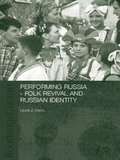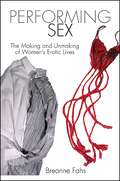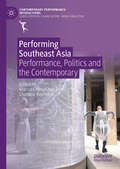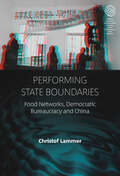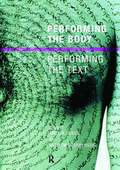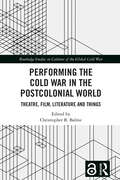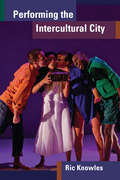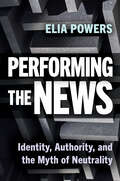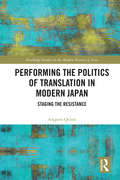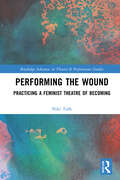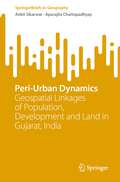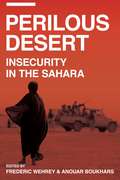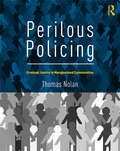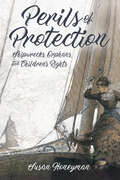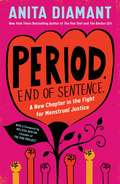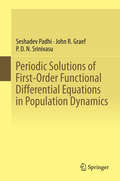- Table View
- List View
Performing Russia: Folk Revival and Russian Identity (BASEES/Routledge Series on Russian and East European Studies)
by Laura OlsonThis book examines folk music and dance revival movements in Russia, exploring why this folk culture has come to represent Russia, how it has been approached and produced, and why memory and tradition, in these particular forms, have taken on particular significance in different periods. Above all it shows how folk "tradition" in Russia is an artificial cultural construct, which is periodically reinvented, and it demonstrates in particular how the "folk revival" has played a key role in strengthening Russian national consciousness in the post-Soviet period.
Performing Self in Ethnographic Fieldwork
by Marilena PapachristophorouThis provocative book presents a methodological proposal for teaching ethnographic fieldwork, applying interdisciplinary tools inspired from performance theory, acting, experiential anthropology and existential psychotherapy. At the same time, it constitutes a theoretical and methodological trajectory mapping the history of ethnographic fieldwork through highly characteristic moments along with the author's own personal journey in the field in terms of a lifetime project. Starting from the assumption that ethnographic fieldwork constitutes a deeply human experience, the book proposes a step further towards the performative dimension of an ethnographic condition inspired by the Stanislavski method, which in practice complements performance theory issues: it is argued that participant observation offers an intermediate identity for the ethnographer through a conscious management of the social "role" dictated by their research participants; this ethnographic mediation of the Self may also have psychotherapeutic effects, mainly through conscious management of self-diversity and reflexivity in ethnographic writing. Ethnographic fieldwork is thus highlighted as a performative stage and a field of deep transformations for the ethnographer’s identity.
Performing Sex: The Making and Unmaking of Women's Erotic Lives
by Breanne FahsSilver Medalist, 2012 Independent Publisher Book Awards in the Women's Issues categoryHonorable Mention, 2011 ForeWord Book of the Year in the Women's Issues CategoryAlthough conventional wisdom holds that women in the United States today are more sexually liberated than ever before, a number of startling statistics call into question this perceived victory: over half of all women report having faked orgasms; 45 percent of women find rape fantasies erotic; a growing number of women perform same-sex eroticism for the viewing benefit of men; and recent clinical studies label 40 percent of women as "sexually dysfunctional." Caught between postsexual revolution celebrations of progress and alarmingly regressive new modes of disempowerment, the forty women interviewed in Performing Sex offer a candid and provocative portrait of "liberated" sex in America. Through this nuanced and complex study, Breanne Fahs demonstrates that despite the constant cooptation of the terms of sexual freedom, women's sexual subjectivities—and the ways they continually grapple with shifting definitions of liberation—represent provocative spaces for critical inquiry and personal discovery, ultimately generating novel ways of imagining and reimagining power, pleasure, and resistance.
Performing Social Change on the Island of Ireland: From Republic to Pandemic (Routledge Advances in Theatre & Performance Studies)
by Ciara L. MurphyThis book examines the relationship between moments of significant social change on the island of Ireland and performance practice during the twentieth and twenty-first centuries. It examines how moments of significant change influence not only the content of performance practice but also the form and function of theatre production and reception. This book investigates how the Troubles and subsequent Peace Process, Second-Wave Feminism, the Celtic Tiger and neoliberalism, social revolution, and the COVID-19 pandemic impacts the form and function of performance practice across the island of Ireland. Although these forms of theatre and performance making refer to varied and distinct lineages of practice internationally, there are key parallels that compel a study of their inter-relationality in a specific Irish context This book explores how the performance of Ireland illuminates histories and stories that are on the margins, illuminating the lived realities of everyday life through the presentation of moments of violence, oppression, and trauma as something that is as important as the larger narratives often ascribed to nationhood. This book asks how performance practice engages with and informs moments of major social change on the island of Ireland through the distinct yet intersecting lenses of place, performance form, and social context over the course of almost a century of Irish theatre and performance practice.
Performing Southeast Asia: Performance, Politics and the Contemporary (Contemporary Performance InterActions)
by Marcus Cheng Chye Tan Charlene Rajendran"Performing Southeast Asia: Performance, Politics and the Contemporary is an important reconsideration of the histories and practices of theatre and performance in a fluid and dynamic region that is also experiencing an overarching politics of complexity, precarity and populist authoritarian tendencies. In a substantial introductory essay and essays by leading scholars, activists and practitioners working inside the region, the book explores fundamental questions for the arts. The book asks how theatre contributes to and/or addresses the political condition in the contemporary moment, how does it represent the complexity of experiences in peoples’ daily lives and how does theatre engage in forms of political activism and enable a diversity of voices to flourish. The book shows how, in an age of increasingly violent politics, political institutions become sites for bad actors and propaganda. Forces of biopolitics, neo-liberalism and religious and ethnic nationalism intersect in unpredictable ways with decolonial practices – all of which the book argues are forces that define the contemporary moment. Indeed, by putting the focus on contemporary politics in the region alongside the diversity of practices in contemporary theatre, we see a substantial reformation of the idea of the contemporary moment, not as a cosmopolitan and elite artistic practice but as a multivalent agent of change in both aesthetic and political terms. With its focus on community activism and the creative possibilities of the performing arts the region, Performing Southeast Asia, is a timely intervention that brings us to a new understanding of how contemporary Southeast Asia has become a site of contest, struggle and reinvention of the relations between the arts and society." - Peter Eckersall, The Graduate Center, City University of New York, USA "Performing Southeast Asia – with chapters concerned with how regional theatres seek contextually-grounded, yet post-national(istic) forms; how history and tradition shape but do not hold down contemporary theatre; and how, in the editors’ words, such artistic encounters could result in theatres ‘that do not merely attend to matters of cultural heritage, tradition or history, but instead engage overtly with theatre and performance in the contemporary’ – contributes to the possibility of understanding what options for an artistically transubstantiated now-ness may be: to the possibility, that is, of what might be called a ‘Present-Tense Theatre’." - C. J. W.-L. Wee, Professor of English, Nanyang Technological University, SingaporeThis book examines contemporary performance practices and politics in Southeast Asia. It analyses performances created and performed in Southeast Asia, with specific focus on particular nation states, as these engage the volatile or shifting cultures and politics that inform contemporary life, particularly in urban Southeast Asia. In a region haunted historically by political divergence, authoritarianism and militarism, religious diversity and ethnic strife, the chapters reveal how contemporary performance, and performances today reflect yet challenge dominant socio-political discourses. The authors centre their discussion on the efficacies of performance as political intervention in Southeast Asia in a time of seismic socio-political change. They consider issues of state hegemonies, censorship, the resurgence of authoritarianism, the persistence of history and tradition, the impact of finance and sponsorship, social liberalism and conservatism and globalisation and cultural practice.
Performing State Boundaries: Food Networks, Democratic Bureaucracy and China (EASA Series #51)
by Christof LammerPolarizing images of authoritarian, socialist or culturalist otherness compromise analyses of the Chinese state. Still, such images produce effects beyond academia when they inform performances of the boundaries between state and non-state. This book shows how performative boundary work leads to contrasting judgements that decide about support and access to resources. In an ecological village in Sichuan, citizen participation in food networks and bureaucracy signaled Western liberalism, Maoism or traditional rural culture for different audiences. Attention to the multiplicity of performed state boundaries helps China studies and political anthropology to understand such diverging classifications – and how they sometimes co-exist without causing tensions.
Performing al-Andalus
by Jonathan Holt ShannonPerforming al-Andalus explores three musical cultures that claim a connection to the music of medieval Iberia, the Islamic kingdom of al-Andalus, known for its complex mix of Arab, North African, Christian, and Jewish influences. Jonathan Holt Shannon shows that the idea of a shared Andalusian heritage animates performers and aficionados in modern-day Syria, Morocco, and Spain, but with varying and sometimes contradictory meanings in different social and political contexts. As he traces the movements of musicians, songs, histories, and memories circulating around the Mediterranean, he argues that attention to such flows offers new insights into the complexities of culture and the nuances of selfhood.
Performing the Body/Performing the Text
by Amelia Jones Andrew StephensonThis book explores the new performativity in art theory and practice, examining ways of rethinking interpretive processes in visual culture. Since the 1960s, visual art practices - from body art to minimalism - have taken contemporary art outside the museum and gallery; by embracing theatricality and performance and exploding the boundaries set by traditional art criticism. The contributors argue that interpretation needs to be recognised as much more dynamic and contingent. Offering its own performance script, and embracing both canonical fine artists such as Manet, De Kooning and Jasper Johns, and performance artists such as Vito Acconci and Gunter Brus, this book offers radical re-readings of art works and points confidently towards new models for understanding art.
Performing the Cold War in the Postcolonial World: Theatre, Film, Literature and Things (Routledge Studies in Cultures of the Global Cold War)
by Christopher B. BalmeThis volume explores how the Cultural Cold War played out in Africa and Asia in the context of decolonization. Both the United States and the Soviet Union as well as East European states undertook significant efforts to influence cultural life in the newly independent, postcolonial world. The different forms of influence are the subject of this book. The contributions are grouped around four topic headings. "Networks and Institutions" looks at the various ways Western-style theatre became institutionalized in the decolonial world, especially Africa. "Cultural Diplomacy" focuses on the activities of the Soviet Union in India in the late 1950s and 1960s in the very different arenas of book publishing and the circus. "Artists and Agency" explores how West African filmmakers (Ousmane Sembène and Abderrahmane Sissako) and European authors (Brecht and Ibsen) were harnessed for different kinds of Cold War strategies. Finally, "Cultures of Things" investigates how everyday objects such as books and iconic theatre buildings became suffused with affect, nostalgia, and ideology. This book will be of interest for students of the Cold War, postcolonial studies, theatre, film, and literature. Chapters 1, 4, 8, and 11 of this book is freely available as a downloadable Open Access PDF at http://www.taylorfrancis.com under a Creative Commons [Attribution-Non Commercial-No Derivatives (CC-BY-NC-ND)] 4.0 license. Funded by the European Research Council Project "Developing Theatre".
Performing the Intercultural City
by Ric KnowlesIn 1971, Canada became the first country to adopt an official policy of multiculturalism. Performing the Intercultural City explores how Toronto—a representative global city in this multicultural country—stages diversity through its many intercultural theater companies and troupes. The book begins with a theoretical introduction to theatrical interculturalism. Subsequent chapters outline the historical and political context within which intercultural performance takes place; examine the ways in which Indigenous, Filipino, and Afro-Caribbean Canadian theater has developed play structures based on culturally specific forms of expression; and explore the ways that intercultural companies have used intermediality, modernist form, and intercultural discourse to mediate across cultures. Performing the Intercultural City will appeal to scholars, artists, and the theater-going public, including those in theater and performance studies, urban studies, critical multiculturalism studies, diaspora studies, critical cosmopolitanism studies, critical race theory, and cultural studies.
Performing the News: Identity, Authority, and the Myth of Neutrality
by Elia PowersPerforming the News: Identity, Authority, and the Myth of Neutrality explores how journalists from historically marginalized groups have long felt pressure to conform when performing for audiences. Many speak with a flat, “neutral” accent, modify their delivery to hide distinctive vocal attributes, dress conventionally to appeal to the “average” viewer, and maintain a consistent appearance to avoid unwanted attention. Their aim is what author Elia Powers refers to as performance neutrality—presentation that is deemed unobjectionable, reveals little about journalists’ social identity, and supposedly does not detract from their message. Increasingly, journalists are challenging restrictive, purportedly neutral forms of self-presentation. This book argues that performance neutrality is a myth that reinforces the status quo, limits on-air diversity, and hinders efforts to make newsrooms more inclusive. Through in-depth interviews with journalists in broadcasting and podcasting, and those who shape their performance, the author suggests ways to make journalism more inclusive and representative of diverse audiences.
Performing the Politics of Translation in Modern Japan: Staging the Resistance (Routledge Studies in the Modern History of Asia)
by Aragorn QuinnPerforming the Politics of Translation in Modern Japan sheds new light on the adoption of concepts that motivated political theatres of resistance for nearly a century and even now underpin the collective understanding of the Japanese nation. Grounded in the aftermath of the Meiji Restoration in 1868 and analyzing its legacy on stage, this book tells the story of the crucial role that performance and specifically embodied memory played in the changing understanding of the imported Western concepts of "liberty" (jiyū) and "revolution" (kakumei). Tracing the role of the post-Restoration movement itself as an important touchstone for later performances, it examines two key moments of political crisis. The first of these is the Proletarian Theatre Movement of the 1920s and '30s, in which the post-Restoration years were important for theorizing the Japanese communist revolution. The second is in the postwar years when Rights Movement theatre and thought again featured as a vehicle for understanding the present through the past. As such, this book presents the translation of "liberty" and "revolution", not through a one-to-one correspondence model, but rather as a many-to-many relationship. In doing so, it presents a century of evolution in the dramaturgy of resistance in Japan. This book will be useful to students and scholars of Japanese history, society and culture, as well as literature and translation studies alike.
Performing the Wound: Practicing a Feminist Theatre of Becoming (Routledge Advances in Theatre & Performance Studies)
by Niki TulkThis book offers a matrixial, feminist-centered analysis of trauma and performance, through examining the work of three artists: Ann Hamilton, Renée Green, and Cecilia Vicuña. Each artist engages in a multi-media, or “combination” performance practice; this includes the use of site, embodied performance, material elements, film, and writing. Each case study involves traumatic content, including the legacy of slavery, child sexual abuse and environmental degradation; each artist constructs an aesthetic milieu that invites rather than immerses—this allows an audience to have agency, as well as multiple pathways into their engagement with the art. The author Niki Tulk suggests that these works facilitate an audience-performance relationship based on the concept of ethical witnessing/wit(h)nessing, in which viewers are not positioned as voyeurs, nor made to risk re-traumatization by being forced to view traumatic events re-played on stage. This approach also allows agency to the art itself, in that an ethical space is created where the art is not objectified or looked at—but joined with. Foundational to this investigation are the writings of Bracha L. Ettinger, Jill Bennett and Diana Taylor—particularly Ettinger’s concepts of the matrixial, carriance and border-linking. These artists and scholars present a capacity to expand and articulate answers to questions regarding how to make performance that remains compelling and truthful to the trauma experience, but not re-traumatizing. This study will be of great interest to students and scholars of performance studies, art history, visual arts, feminist studies, theatre, film, performance art, postcolonialism, rhetoric and writing.
Perfume Dreams: Reflections on the Vietnamese Diaspora
by Andrew LamIn his long-overdue first collection of essays, noted journalist and NPR commentator Andrew Lam explores his lifelong struggle for identity as a Viet Kieu, or a Vietnamese national living abroad. At age eleven, Lam, the son of a South Vietnamese general, came to California on the eve of the fall of Saigon to communist forces. He traded his Vietnamese name for a more American one and immersed himself in the allure of the American dream: something not clearly defined for him or his family. Reflecting on the meanings of the Vietnam War to the Vietnamese people themselves—particularly to those in exile—Lam picks with searing honesty at the roots of his doubleness and his parents’ longing for a homeland that no longer exists.
Perfume Dreams: Reflections on the Vietnamese Diaspora
by Andrew Lam“Much will be made—and rightly so—of the eloquent commentary [Lam’s] essays provide on Vietnam and the Vietnamese . . . a fascinating and important book.” —Robert Olen Butler, Pulitzer Prize–winning authorA PEN American Beyond Margins Award winnerIn his long-overdue first collection of essays, noted journalist and NPR commentator Andrew Lam explores his lifelong struggle for identity as a Viet Kieu, or a Vietnamese national living abroad. At age eleven, Lam, the son of a South Vietnamese general, came to California on the eve of the fall of Saigon to communist forces. He traded his Vietnamese name for a more American one and immersed himself in the allure of the American dream: something not clearly defined for him or his family. Reflecting on the meanings of the Vietnam War to the Vietnamese people themselves—particularly to those in exile—Lam picks with searing honesty at the roots of his doubleness and his parents’ longing for a homeland that no longer exists.“Lam shatters the assumptions of readers who have encountered the Vietnam experience only through American pop culture . . . He writes with the delicacy and intensity of a poet.” —Los Angeles Times Book Review“Andrew Lam writes with the honesty of a true journalist and the feeling of a born storyteller. On his many journeys between Vietnam and the U.S., he sees first-hand the global consequences of war. Perfume Dreams is a meaningful book for our times.” —Maxine Hong Kingston, national bestselling author of The Woman Warrior“Lam’s insights into Asian American life are reflected in candid, witty anecdotes that reveal much about the difficulties of living in two cultures.” —Audrey Magazine
Peri-Urban Dynamics: Geospatial Linkages of Population, Development and Land in Gujarat, India (SpringerBriefs in Geography)
by Ankit Sikarwar Aparajita ChattopadhyayUrban expansion beyond the city’s administrative boundaries has altered villages to a great extent. These peri-urban villages are experiencing unforeseen changes in demographic, economic, land-use, and environmental characteristics. The concept of peri-urbanization is grabbing the attention of urban planners and policymakers globally. To understand the dynamics of the peri-urban region it is crucial to examine multiple rural and urban characteristics. This book studies major changes in population, land and development with the integration of remotely sensed data and census data for 615 peri-urban villages surrounding Ahmedabad city of India. The chapters of the book are designed to cover key aspects of peri-urban change with geospatial methods. This book offers a comprehensive understanding and importance of analyzing peri-urban dynamics at the smallest spatial unit. It provides a detailed conceptual and methodological framework for the students and researchers to study peri-urbanization as well as for the policymakers to redefine the urban policies.
Peri-urban Water and Sanitation Services
by Mathew Kurian Patricia MccarneyMore than 2.6 billion people in the developing world lack access to safe water and sanitation service. The Millennium Development Goal's (MDG) target is to halve the number of people without access to a sustainable source of water supply and connection to a sewer network by 2015. That target is unlikely to be met. If there is anything that can be learnt from European experience it is that institutional reform occurs incrementally when politically enfranchised urban populations perceive a threat to their material well-being due to contamination of water sources.
Perilous Desert
by Frederic Wehrey Anouar BoukharsThe geopolitical significance of the Sahara is becoming painfully clear. Islamist militant groups and transnational criminal networks are operating in the region's most fragile states, exploiting widespread corruption, weak government capacity, crushing poverty, and entrenched social and ethnic tensions. The unrest spills over borders and aggravates protracted regional crises.This insecurity raises urgent concerns for the broader Sahara and the West. Perilous Desert details the sources of instability and what can be done to minimize the threat of simmering conflicts.Leading experts, through comprehensive accounts of the changing landscape, demonstrate how foreign assistance that relies exclusively on counterterrorism will only exacerbate the problems. Solutions require understanding and combatting the roots of the Sahara's many challenges.
Perilous Policing: Criminal Justice in Marginalized Communities
by Thomas NolanPolicing and police practices have changed dramatically since the 9/11 terrorist attacks and those changes have accelerated since the summer of 2014 and the death of Michael Brown at the hands of then-police officer Darren Wilson in Ferguson, Missouri. Since the November 2016 election of Donald Trump as president, many law enforcement practitioners, policy makers, and those concerned with issues of social justice have had concerns that there would be seismic shifts in policing priorities and practices at the federal, state, county, and local and tribal levels that will have significant implications for constitutional rights and civil liberties protections, particularly for people of color. Perilous Policing: Criminal Justice in Marginalized Communities provides a much-needed interrogatory to law enforcement practices and policies as they continue to evolve during this era of uncertainty and anxiety. Key topics include the police and marginalized populations, the use of technology to surveil individuals and groups, the emergence of the Black Lives Matter movement and the erosion of the police narrative, the use of force (particularly deadly force) against people of color, the role of the police in immigration enforcement, the "war on cops," and police militarization. Thomas Nolan’s critique of current practice and his preliminary conclusions as to how to navigate contemporary policing away from the pitfalls of discredited and counterproductive practices will be of interest to advanced undergraduates and graduate students in Policing, Criminology, Justice Studies, and Criminal Justice programs, as well as to researchers, law enforcement professionals, and police policy makers.
Perilous Wagers: Gambling, Dignity, and Day Laborers in Twenty-First-Century Tokyo (Studies of the Weatherhead East Asian Institute, Columbia University)
by Klaus K. HammeringThe lives of the men depicted in Perilous Wagers take place in the squalor of Tokyo's old day-laborer district, San'ya, where they can be found eking out a living from occasional construction work and welfare handouts, permanently displaced from their hometowns to metropolitan Tokyo. Although San'ya has nearly vanished during the past twenty years, its import persists as a black market where its small population of male day-laborers can be contracted for the most undesirable of tasks, without consideration for their health or safety. In this context, Hammering's book examines classic ethnographic themes of labor, exchange, value, honor, shame, temporality, desire, gender, and personhood. It explores how one group of day-laborers embodied a transgressive masculinity intimately intertwined with honorable mobster values of old, and how they created dignity and sociality under abject conditions of life. Perilous Wagers tracks these underdog values across construction sites, non-profit organizations, hospitals, bunkhouses, and illegal gambling dens, giving imaginative life to a stigmatized, forgotten social world.
Perils of Protection: Shipwrecks, Orphans, and Children's Rights (Children's Literature Association Series)
by Susan HoneymanWinner of the Children’s Literature Association’s 2020 Honor Book AwardUnrecognized in the United States and resisted in many wealthy, industrialized nations, children’s rights to participation and self-determination are easily disregarded in the name of protection. In literature, the needs of children are often obscured by protectionist narratives, which redirect attention to parents by mythologizing the supposed innocence, victimization, and vulnerability of children rather than potential agency.In Perils of Protection: Shipwrecks, Orphans, and Children's Rights, author Susan Honeyman traces how the best of intentions to protect children can nonetheless hurt them when leaving them unprepared to act on their own behalf. Honeyman utilizes literary parallels and discursive analysis to highlight the unchecked protectionism that has left minors increasingly isolated in dwindling social units and vulnerable to multiple injustices made possible by eroded or unrecognized participatory rights.Each chapter centers on a perilous pattern in a different context: “women and children first” rescue hierarchies, geographic restriction, abandonment, censorship, and illness. Analysis from adventures real and fictionalized will offer the reader high jinx and heroism at sea, the rush of risk, finding new families, resisting censorship through discovering shared political identity, and breaking the pretenses of sentimentality.
Period. End of Sentence.: A New Chapter in the Fight for Menstrual Justice
by Anita DiamantFrom beloved New York Times bestselling author and award-winning journalist Anita Diamant comes a timely collection of essays to help inspire period positive activism around the globe. <P><P> When Period. End of Sentence. won an Oscar in 2019, the film’s co-producer and Executive Director of The Pad Project, Melissa Berton, told the audience: “A period should end a sentence, not a girl’s education.” Continuing in that revolutionary spirit and building on the momentum of the acclaimed documentary, this book outlines the challenges facing those who menstruate worldwide and the solutions championed by a new generation of body positive activists, innovators and public figures. Including interviews from people on the frontlines—parents, teachers, medical professionals, and social-justice warriors—Period. End of Sentence. illuminates the many ways that menstrual injustice can limit opportunities, erode self-esteem, and even threaten lives. <P><P> This powerful examination of the far-ranging and quickly evolving movement for menstrual justice introduces today’s leaders and shows us how we can be part of the change. <P><P> Fearless, revolutionary, and fascinating, Period. End of Sentence. is an essential read for anyone interested in empowering women, girls, and others around the world. <P><P> To learn more about The Pad Project, go to ThePadProject.org.
Period: The Real Story of Menstruation
by Kate ClancyA bold and revolutionary perspective on the science and cultural history of menstruationMenstruation is something half the world does for a week at a time, for months and years on end, yet it remains largely misunderstood. Scientists once thought of an individual&’s period as useless, and some doctors still believe it&’s unsafe for a menstruating person to swim in the ocean wearing a tampon. Period counters the false theories that have long defined the study of the uterus, exposing the eugenic history of gynecology while providing an intersectional feminist perspective on menstruation science.Blending interviews and personal experience with engaging stories from her own pioneering research, Kate Clancy challenges a host of myths and false assumptions. There is no such a thing as a &“normal&” menstrual cycle. In fact, menstrual cycles are incredibly variable and highly responsive to environmental and psychological stressors. Clancy takes up a host of timely issues surrounding menstruation, from bodily autonomy, menstrual hygiene, and the COVID-19 vaccine to the ways racism, sexism, and medical betrayal warp public perceptions of menstruation and erase it from public life.Offering a revelatory new perspective on one of the most captivating biological processes in the human body, Period will change the way you think about the past, present, and future of periods.
Period: Twelve Voices Tell the Bloody Truth
by Edited by Kate FarrellPeriods enter the spotlight in this essay collection that raises a variety of voices on a topic long shrouded in shame and secrecy.In this collection, writers of various ages and across racial, cultural, and gender identities share stories about the period. Each of our twelve authors brings an individual perspective and sensibility. They write about homeless periods, nonexistent periods, male periods, political periods, and more. Told with warmth and humor, these essays celebrate all kinds of period experiences. Periods are a fact of life. It's time to talk about them.
Periodic Solutions of First-Order Functional Differential Equations in Population Dynamics
by Seshadev Padhi John R. Graef P D N SrinivasuThis book provides cutting-edge results on the existence of multiple positive periodic solutions of first-order functional differential equations. It demonstrates how the Leggett-Williams fixed-point theorem can be applied to study the existence of two or three positive periodic solutions of functional differential equations with real-world applications, particularly with regard to the Lasota-Wazewska model, the Hematopoiesis model, the Nicholsons Blowflies model, and some models with Allee effects. Many interesting sufficient conditions are given for the dynamics that include nonlinear characteristics exhibited by population models. The last chapter provides results related to the global appeal of solutions to the models considered in the earlier chapters. The techniques used in this book can be easily understood by anyone with a basic knowledge of analysis. This book offers a valuable reference guide for students and researchers in the field of differential equations with applications to biology, ecology, and the environment.
